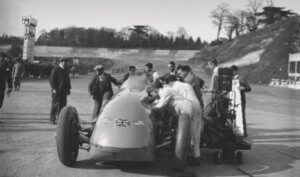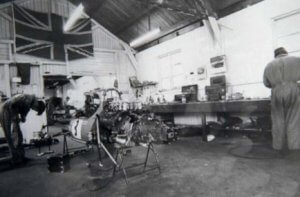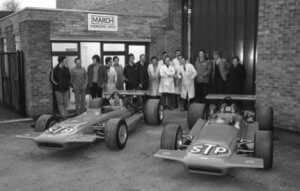The home of Motorsport – F1 at 70
To read the full March edition of Revolution click HERE

Britain’s motorsport industry is worth £10 billion each year. With Formula One’s 70th season almost upon us, Colin Goodwin asks how this tiny island became the epicentre of racing’s premier category and a worldwide hub for motorsport.
We’re going to be hearing a lot about fish over the next few months as politicians and civil servants bash out the details of trade deals. Although we don’t want to get into these dangerous waters it is worth noting that the fishing industry is worth £980 million a year to the UK treasury. That’s a lot of cod, but compared to the motorsport industry’s contribution to the nation’s GDP it’s small fry as our flourishing motorsport engineering industry puts a staggering £10 billion a year into the coffers. That’s not the only mind boggling number connected to our favourite passion. There are 4,500 companies in the UK that are directly related to motorsport that together employ 45,000 people. Eighty-seven percent of these companies export abroad. Of course when most of us think about motorsport in the UK we think of Formula One and, sure enough, F1 teams make up 25 per cent of the sector’s value and employ around 5,200 of the people in the industry. Six of the 10 current F1 teams are based here. A great number of these companies are located in the Silicon Fen or what was trademarked by the Motorsport Industry Association in 2013 as ‘Motorsport Valley’. To mark the beginning of Formula One’s 70th season, we’re taking a journey back in time to the birth of Britain’s motorsport industry to investigate how this country became so prominent on the global motor racing stage.
To start, we will go back to June 17th 1903 and the day that the Brooklands circuit in Weybridge, Surrey, was officially opened. The Motor Car Act of 1903 had introduced a blanket speed limit of 20mph which meant that high speed testing of cars on the public road was impossible. Many, including local landowner Hugh F. Locke King, were concerned that this would hold back the nascent British motor industry at a time when 50 per cent of the world’s cars were built in France. Locke King donated the land and Britain had its first (and the world’s) purposebuilt racing circuit.
In 1909 Brooklands became one of Britain’s first airfields and a year later a flying school was opened there. Racing was halted during the First World War but Brooklands was busier than ever having been requisitioned by the military as a flying school and also as a location for factories that produced military aircraft throughout the war. With the war over, racing returned to Brooklands and with it a host of local engineering businesses that prepared and ran cars for wealthy drivers. One of the most successful was Thomas Inventions Development Co Ltd, set up by J.G. Parry Thomas and Major Ken Thomson. After Parry Thomas was killed at Pendine Sands in 1927 Thomson went into partnership with Ken Taylor to form Thomson & Taylor. Thomson & Taylor built two of Malcolm Campbell’s Bluebird land speed record cars and also, designed by the company’s technical director and chief designer Reid Railton, the chassis for all 17 ERA racing cars built.
Racing finished at Brooklands in 1939 with the outbreak of WW2 when the site once again became the home to wartime aircraft production. Vickers Wellingtons and Hawker Hurricanes were both built in Weybridge in large numbers. Brooklands wasn’t the only aviation centre in the area; in nearby Farnborough was the Royal Aircraft Establishment that throughout both wars and in the inter-war years had been carrying out groundbreaking research. It, like Brooklands, was a fount of engineering and technical skills. After the war racing started again. Brooklands would never re-open for racing but the war had brought with it a massive airfield building programme; airfields that were now surplus to requirements. With their concrete or tarmac perimeter tracks they made perfect racing circuits. RAF Silverstone, a bomber command Operational Training Unit base in the war flying Wellingtons, was one of the first to host motor racing in 1947.
“RAF Silverstone, a bomber command Operational Training Unit base, was one of the first airfields to host motor racing in 1947”
Three years later it hosted the first official Formula One race. The results sheets for that inaugural season are dominated by continental makes, predominantly Alfa Romeo. A few pre-war ERAs were entered and a couple of Altas. Also, in the 1950 Monaco Grand Prix, a lone Cooper. Charles Cooper ran a garage business in Surbiton, Surrey, and his son John served a toolmaker’s apprenticeship before the war and was an instrument maker with the RAF during it. Skills essential for building racing cars. There are numerous reasons why the South East became a hotbed of motor racing engineering in the 1950s and ‘60s but the predominant one is the availability of the skills required to fabricate and weld chassis, turn components on lathes and to panel beat and work soft alloys. All skills that had been learned in the Weybridge and Kingston aircraft factories during the war. Of course, there were aircraft factories spread across the UK during the war but there was more money in the South East and in London so that’s where the reborn motor racing world was focused. Also, London was the home of the 750 Motor Club, the grass roots motor racing club that was founded in 1939 for builders and racers of Austin 7 specials.
Its post war members included Colin Chapman and Eric Broadley of Lotus and Lola respectively. Lotus was established in North London and Lola in Slough and a web of motor racing manufacturers and component suppliers started to develop around Surrey and Middlesex. Cooper was already established in Surbiton and can probably be credited with kickstarting the industry in this area. Jack Brabham arrived from Australia to work at Cooper, both building cars, and driving for the team. He was followed a couple of years later by Bruce McLaren from New Zealand who became Jack’s team-mate at Cooper in 1959. When Brabham and McLaren left Cooper to start their own teams, it was logical that they should base them in the area that they lived in and knew well. Brabham started in Woking and McLaren in Colnbrook near Heathrow. Another member of the Cooper family was Ockham, Surrey, timber merchant Ken Tyrrell.
Tyrrell had raced Cooper F3 cars in the 1950s before realising that he’d make a better team manager than driver and took over the running of Cooper’s Formula Junior team. In 1968 Tyrrell promoted himself into Formula One by forming a partnership with French aeronautical giant Matra before constructing his own Tyrrell 001 for the 1971 season. Tyrrell’s first aluminium monocoque was constructed down the road at the Old Woking premises of Gomm Metal Developments. Maurice ‘Mo’ Gomm had learnt his metal work craft at Vickers iWeybridge building Wellington bombers. Gomm built not only the tubs for Tyrrell, but made the shells for Ford’s legendary works Escort rally cars and numerous components for racing cars including oil tanks for GT40s (built at Ford Advanced Vehicles in Slough, just around the corner from Lola). The South East motorsport community wasn’t all Formula One in the Sixties and early Seventies. Alan Mann Racing was based in Byfleet, a stone’s throw from the old Brooklands circuit and close to Ron Tauranac’s RALT workshops. The area didn’t have a monopoly on the motorsport industry. Colin Chapman, needing more space for road car production, moved from North London to Hethel in Norfolk at the end of the ‘60s. BRM was founded in Bourne, Lincolnshire, in buildings adjacent to the old ERA workshops. And then there was March Engineering.
“As we move further into the era of electrification, Motorsport Valley will play an even more important role”
 Founded by Max Mosley, Alan Rees, Charles Coaker and Robin Herd in 1969, the F1 constructor and prolific formula car builder was set up in Bicester as one of the first teams to settle in what is now Motorsport Valley. Incidentally, before he joined McLaren and then jointly founded March, Robin Herd worked at the Royal Aircraft Establishment at Farnborough on the development of Concorde. Frank Williams, after several decades of ducking and diving, established his eponymous F1 team in Grove, Oxfordshire, in 1977. The migration of the motorsport engineering world to the Midlands was beginning. But why? Gordon Murray moved to the UK from South Africa in 1969 and after, a job at Lotus fell through, started in Brabham’s drawing office before taking over as chief designer in 1972. “For one thing,” Murray tells us, “the South East was an expensive place to build racing cars. When I started at Brabham there were
Founded by Max Mosley, Alan Rees, Charles Coaker and Robin Herd in 1969, the F1 constructor and prolific formula car builder was set up in Bicester as one of the first teams to settle in what is now Motorsport Valley. Incidentally, before he joined McLaren and then jointly founded March, Robin Herd worked at the Royal Aircraft Establishment at Farnborough on the development of Concorde. Frank Williams, after several decades of ducking and diving, established his eponymous F1 team in Grove, Oxfordshire, in 1977. The migration of the motorsport engineering world to the Midlands was beginning. But why? Gordon Murray moved to the UK from South Africa in 1969 and after, a job at Lotus fell through, started in Brabham’s drawing office before taking over as chief designer in 1972. “For one thing,” Murray tells us, “the South East was an expensive place to build racing cars. When I started at Brabham there were
14 people in the team including the secretary working from a ridiculously small workshop. As teams began to grow the costs went up.” Also, as teams began to build more and more components in-house, the reliance on outside suppliers was reduced. “That’s very true,” agrees Murray. “It was part of our philosophy at Brabham to bring parts in-house, often to make them better. When I started in F1 virtually everyone used Hewland gearboxes [founded by Mike Hewland in Maidenhead in 1959] but in 1973 we built our own pioneering dry-sump gearbox.” In the early days of wind tunnel testing, teams would use existing tunnels, but by the 1980s it was becoming essential to have your own tunnel on the premises so that parts could be tested 24/7. And wind tunnels take up a lot of space and aren’t particularly quiet. The first composite monocoques were built by outside suppliers, but eventually these too moved in-house and that meant space was needed for vast autoclaves. Today a whole new network of suppliers and component manufacturers has been created in this vibrant region of groundbreaking technology. And as we move further into the era of electrification, Motorsport Valley will play an even more important role. Motorsport has always played a big part in the development of technologies that eventually found their way onto road cars, but perhaps never more so than today. Kinetic Energy Recovery Systems (KERS for short), pioneered in F1, is now an integral part of the new EV revolution.
The white heat of technological development in motorsport will no doubt contribute to other areas apart from road cars. It’s very likely that the motorsport engineering industry will play an important part in the development of electrified aviation. It’s logical, too, that the energy management systems developed in Formula E and other electrified racing series will eventually find a place in passenger carrying drones and delivery systems. It’s a wonderful thought that the close relationship between motorsport and aviation that was forged at Brooklands in the early part of the 20th century will continue and burn even brighter in the 21st century.
To read the full March edition of Revolution click HERE



